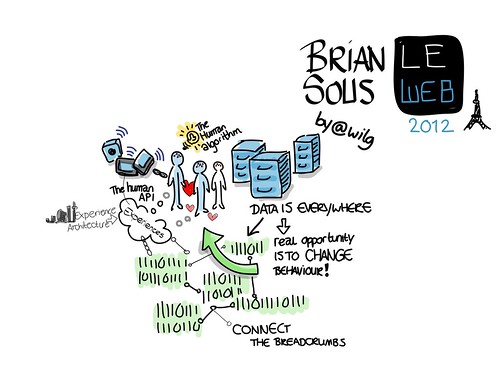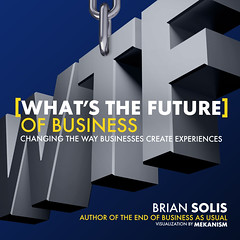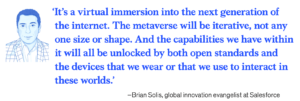I had the opportunity to present at LeWeb in Paris, arguably Europe’s largest conference dedicated to the future of technology. The theme of the conference explored the Internet of Things, where devices and things connect to one another to perform certain tasks and/or track activities to improve what we already do or make possible what we’re trying to do.
The Internet of Things is bigger than we may realize. We are experiencing a shift from a world of inanimate objects and reactive devices to a world where data, intelligence, and computing are distributed, ubiquitous, and networked. My fellow analysts and I at Altimeter Group refer to the Internet of Things (IoT) as the Sentient World. It’s the idea that inanimate objects gain the ability to perceive things, perform tasks, adapt, or help you adapt over time. And, it’s the future of the Internet and consumer electronics.
In 2008, the number of things connected to the Internet exceeded the number of people on earth. By 2020, it’s expected that there will be 50 billion things connected.
A network of things creates an incredible information ecosystem that connects the online and physical world through a series of transactions. In a world where data becomes a natural bi-product of these exchanges, developers, businesses, and users alike are faced with the reality that data isn’t only big, its volume and benefits are also overwhelming.
Did you know that the world creates 2.5 quintillion bytes of new data every day? According to IBM, 90% of the data in the world today has been created in the last two years alone.
Considering the relationship between the Internet, data, and devices, I can’t help but think about Marshall McLuhan’s ominous words, “The more data banks record about each one of us, the less we exist.”
With the Internet of Things, that data takes residence in the cloud with various devices and apps siphoning and funneling information in and out, requiring an incredible amount of vision and architecture to organize, analyze, and present it in a way that makes sense while also offering insight and utility. Instead of eclipsing our individuality, I believe the future may reveal the exact opposite. There’s a sense of empowerment and personalization that emerges and, along the way, we subconsciously and consciously begin to crave it. We become insatiable in our pursuit of personalized feedback and it may, in fact, define us.
The Convergence of Devices, Data and the Net
We’re starting to realize the magic of the IoT today in some of the most basic aspects of our lives. While at Le Web, the audience was introduced to Lockitron, a clever system that combines a mobile app, a household device that mounts to existing door locks, and the Internet to open and close doors remotely. I immediately thought of a partnership with Airbnb to give renters peace of mind in controlling their rentals.
Nest is disrupting the long dormant world of thermostats by connecting mobile devices to existing thermostats (heating/air conditioning) with the simplicity and elegance of an iPod. But it’s more than controlling energy and temperatures remotely, Nest learns and begins to adapt without input.
Square’s Jack Dorsey has disrupted the age old world of payment systems by transforming mobile devices into cash registers, connecting money, data, and the net into one frictionless transaction. It’s the data part that represents something so much more however. In that regard, Dorsey sees the real value beyond the transaction—where the swipe and the receipt ultimately become a communication medium. In his view, payments represent “a necessary transaction” to create a channel where merchants learn more about individual consumers and equally, consumers learn more about their behavior.
The Convergence of People, Devices, Data and the Net
When I marvel at the future of the Internet of Things, I can’t help but think about another often shared idea from McLuhan that, “the medium is the message.”
There’s more to smart appliances and devices than utility or remotely controlling our surroundings. The underlying current of this powerful information exchange are the experiences that surround and emanate from each transaction.
What if the medium wasn’t just the device, the medium was us?
At the center of the IoT and Big Data are the very people who fuel the constant exchange of information. At the same time, it creates a human network, where we become nodes and the information that ties together people and devices feeds new experiences and changes our behavior over time.
This is an era of which my good friend Loic Le Meur and I refer to as the Human API, the idea that who we are, who we know, what we experience and do are important layers in the Internet of Things. While this may sound foreboding, we do in fact become part of the “machine.” I’m not referring to Skynet or Raymond Kurzweil’s theory of Singularity, however. I’m talking about how we open the door to a new generation of technology development that improves lifestyles and enhances relationships while unlocking aspirations.
If you’re unfamiliar with the meaning of API, it stands for application programming interface. Simplified, it’s an interface for programmers to develop upon a common platform where software can communicate with other software objects and also devices.
The Human API represents an opportunity for relationships and technology to be linked by an open source platform…you.
The Medium IS the Message
Revisiting McLuhan’s “medium is the message,” where the form of a medium embeds itself in the message, as a result, it creates a symbiotic relationship by which the medium influences how the message is perceived. The idea of the Human API sets the stage for devices to not only talk to one another, but also talk to us and affect how we process and adapt information to influence how we go through life every day.
If we intentionally program for the Human API, I believe we can design a complementary track within the Internet of Things where products combine utility, experiences, and outcomes.
Let me give you a simple example. Fitbit, makers of wireless trackers and scales, had a tremendous presence at LeWeb. Many speakers and attendees wore these wireless devices to track steps, distance, calories burned, and stairs climbed. At night, it measures sleep cycles, to help users learn how to sleep better. The intention is to motivate you to reach your goals by bringing greater fitness into your life. It is the social element and the corresponding activity that I also find fascinating.
Products such as Fitbit and also Nike’s FuelBand build upon the Human API by collecting the digital breadcrumbs of users and assembling them in a way that makes sense of daily activity and validates progress. Perhaps more importantly, these devices, the data they collect and present, and the social relationships linked by publishing this information in social channels drives the ongoing pursuit of goals, and brings people together to help one another live better. As these devices are connected socially, experiences become the epicenter of engagement and encouragement, inspiring people and networks of people through extended relationships along the way. Imagine if they could also talk to one another…across devices and also across the various contexts of usage, personal, professional, medical, etc.
That’s the point.
Over the years, many developers have created specialized apps and devices that helped us accomplish things through creative “life hacks.” These hacks have given us a taste of what’s possible and are now about to become a way of life. To do so, they now require intentional design to create desired experiences and to change behavior and bring about thoughtful outcomes.
The Human API and the Need for Experience Architecture
Designing new threads within the Internet of Things around people, information, and devices requires architecture. Rather than exploring the deeper convergence of human and machine (“singularity”), the idea of solidarity seems more apropos here and now. I’m not referring to the trade union movement in Poland during the 1980s that inspired opposition to communist regimes across Eastern Europe. I think of solidarity in this case as a movement where individuals come together around a common interest to promote mutual support within the group.
Developing solutions that spark solidarity is only possible through experience architecture. This is where the next generation of visionaries and leaders will push us forward for they represent an emergent genre of experience architects.
This is where you come in…
The Human API opens up tremendous opportunities to develop devices, apps, and experiences that connect information, people, and aspirations to change behavior….on a common platform. This form of human interface design introduces the potential to create harmony in a world of digital chaos, making sense of noise and information overload to accomplish tangible goals or help people see or do things they didn’t or couldn’t before. In the process, we strengthen on our connections around common goals and interests.
This raises questions that experience architects need to consider:
1) What does all of this tell us about ourselves and those around us?
2) How do our devices better communicate and improve how we communicate and adapt?
3) How does the IoT bring people together around a purpose, outcomes, or aspirations?
4) How does it enable us to optimize the lives of our users and customers?
5) How can these devices work together to help users get a holistic body rather than disparate streams?
The future of the Internet of Things requires the balance of experience architecture and the exchange of human information between people and machines, and it is beautiful. And, it takes design.
Imagine what we—as users, entrepreneurs, investors, and enterprises—could do with all of this information. Imagine how we can improve connectivity, lifestyles, and relationships by constructing ecosystems that foster meaningful experiences and inspire changes in behavior.
This hyper-connected world will bring devices, systems, information and people closer together … to create new possibilities, all based on human APIs. As experience architects, the future is yours to develop.
What are your thoughts on the idea of the relationship between people, devices, the Internet of Things? Let’s keep the conversation going!
Below is video of my presentation at LeWeb on the Human API. I hope you enjoy it.
UPDATE 1: Foursquare co-founder Naveen Selvadurai wants you to hack his personal API
UPDATE 2: My work and the work of others on the Human API over the years seems to have inspired a new company (read: platform). It sounds promising and I hope that they credit everyone who worked over the years freely to introduce the need for a common platform.
Image credit: Esther Gons
The story continues…
Connect with me: Twitter | LinkedIn | Facebook | Google+ |Youtube | Instagram







A lot of very interesting ideas in this article. Your idea of the opensource human API is a useful term to help frame and provide context to the IoT as it comes to fruition.
Products like Nest, Lockitron, Fitbit and Square are human facing but as products like these develop it may create space for thing facing things. I think this will be the stage where we can start to have meaningful discussions about singularity and Skynet.
Indeed Kevin…indeed.
As you know, I am 100% behind the general concept here and believe that WE are the social platforms that are driving Big Data and Social as a whole. With a Human API, we need to be careful not to abuse the massive power that comes along with the knowledge and insight that the API would contain. Who owns your API? You? If so, could you license your API or the data that is collected around your API to brands. Would this start a movement of Human API trafficking? As Generation C grows to become the majority, how can we keep the intentions of a Human API based around the common good of the human race as a whole, and not simply exploited as the next great move for capitalism?
I love this comment…and your last question. Would love to see this continue in that direction!
IMHO we won’t be able to prevent that from happening. We will gladly and perhaps for most even unknowingly trade our privacy for the next cool toy. Google glass is just the beginning.
As long as internet or computers in general were ‘mysterious’ and required serious effort to use / comprehend, people knew what they were getting into. Today? The net is everywhere. Smartphones, tablets, various other devices, the net of things… All are made (with good reason) to be as easy to use as possible. However, the less effort they require, the less people know about what goes on when they use all these neat tools. Who knows what the various apps on their smartphone do? What data they send where? Who has any idea about e.g. security options in Facebook? Etc.
On the other hand we have the players that know exactly what’s going on, who know exactly how to gather all that data floating around. As an aside, for a long time, police forces and secret services were the main offenders when it came to disregarding privacy, illegally gathering and analysing data. Over the last years there has been quite a shift. Nowadays, internet giants like Google or Amazon are much more in the spotlight when we talk about these issues.
Anyway, I don’t see any chance to prevent serious exploitation of our data from happening unless either a drastic change of behaviour happens across all the big players (extremely unlikely) or the average Joe Webuser will in future be a lot more educated about the issue. Judging from the last years, I see practically zero chance that politics will play any positive role in this. Retaining power at any cost seems be their modus operandi wherever one looks, apart from glaring ignorance of course.
Even if a great enlightening should happen, there remains a good chance that it will amount to nothing. Individually or even in moderately sized groups, our best intentions have no effect if we do not have a voice or a medium to transport our voice. The medium? What else but the internet. But – remember Chicago. After the bombing, mobile networks were brought down to prevent a possible follow-up bombing by remote triggering via a phone call. Perfectly fine, but it shows how easily networks can be taken down in our days. On a much larger scale, recent uprisings in some countries were sometimes met with a complete nationwide net blackout. Whole nations simply did not exist on the web while the government tried to contain the flow of information. Then, let’s not forget the option of nationwide censorship.
Add to that the desire of law enforcement to gather more and more and more data about everybody in a (IMHO futile) quest to know everything about everybody and we are squarely headed in a direction of a fully controlled internet that is very far apart from what it could be – an incredible tool to move humanity as a whole forward.
Sometimes I wonder if the writers who invented cyberpunk did not simply have a time machine in their basement, hop a few decades forward and record what they saw…
Sorry for rambling.
Thank you for this comment. I thoroughly enjoyed reading it. In fact, this is worthy of a blog post in own right. Cheers!
This type of change scares me frankly. Being a boomer I was taught that others don’t need to know about your stuff, whatever that implies. The ability for abuse before protocols and security have been put in place is frightening!
The power of this has only been imagined by people like Ray Bradbury and Rod Sterling. I remember when the desktop computer was first introduced and newscasters at the time suggested in was not that big of a deal because it performed no functions. It was not until applications were developed to fit the technology that it started to take off.
This is where we are now. “Now we boldly go where no where no man has gone before”. Sit down, buckle up, this is going to be quite a ride. Change happens if you’re ready or not.
Great comment Steve. I’m buckled in!
That must have been a really great experience! Aside from that, I agree with everything you are saying, we really are the power behind social media as a whole. With out us, social media wouldn’t be where it is now.
stakeholder and individual responsibility is one of the major issues here. As the world becomes more connected and integrated with people and devices via the internet of things, we have to be more aware and educated of our butterfly effect. Ripples of what we and others tweet, FB update, G+ update about us to the internet ‘knowing’ and servicing our wants and needs, will last for generations. Those with the power and access to snapshot this information for applicable knowledge have to have a belief system that is focussed on the collective benefit for continuous good. May what we do today be done with unconditional love.